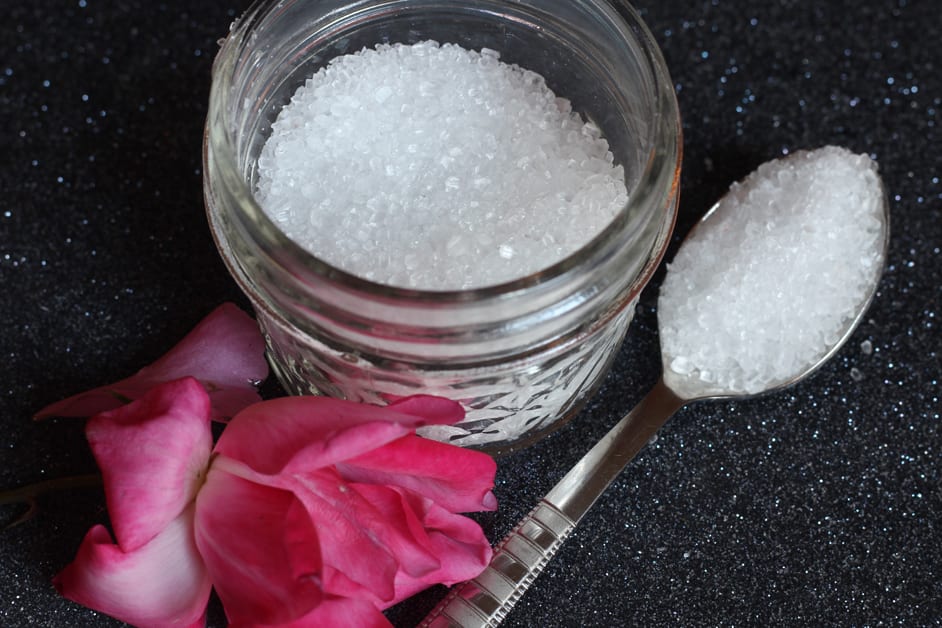Overview of Epsom Salt
Epsom salt is a great natural way to help reduce knee pain. It is a mineral made up of magnesium sulfate which can build up in the body. This helps to reduce inflammation. Taking baths with Epsom salt can also help to release tension and relax sore muscles.
Let’s see how Epsom salt can be used for knee pain relief:
What is Epsom Salt?
Epsom salt is also called magnesium sulfate. It’s made of oxygen, sulfur, and magnesium. It has no smell or taste and dissolves quickly in water. For hundreds of years, it’s been used to treat different conditions such as sore muscles and skin issues. It’s well-known for reducing pain, relaxing muscles, and stimulating circulation when used topically, or in hot baths.
It’s important to remember that Epsom salt has various grades. The most common is the USP Pharmaceutical Grade Epsom Salt. This meets the highest standards for quality and it’s safe to use as directed. Some Epsom salts may contain iodine or additives like citric acid or fragrance. These may irritate skin or eyes, so always read labels before buying. Pure USP Pharmaceutical Grade Epsom salts should be labeled as such.
Benefits of Epsom Salt
Epsom Salt, also known as Magnesium Sulfate, is a type of salt made up of magnesium, sulfur, and oxygen. It can be used both externally and internally, and it has a long history of therapeutic benefits. People use Epsom salt baths to help with joint pain and sore muscles.
Benefits of Epsom Salt Baths:
- Stress and anxiety relief. The salt has a calming effect and a warm Epsom salt bath lowers stress levels and encourages physical relaxation.
- Improved circulation. The magnesium helps blood vessels relax, leading to improved circulation throughout the body. This can reduce fatigue and joint pain.
- Reduced inflammation. Magnesium and sulfur in Epsom salt can reduce inflammation in joints.
- Pain relief. Epsom salts draw out toxins from outside and affected areas, providing fast relief.
These are just some of the many advantages of Epsom salt baths, making them worth adding to your relaxation routine!
How Epsom Salt Can Help Relieve Knee Pain
Epsom salt has been around for a while. It’s a popular home remedy to help with pain, swelling and muscle aches. An Epsom salt bath can also be good for chronic knee pain. We’ll dive into the science behind how these baths can help and how to make the most of them.
Reduce inflammation
Epsom salt is an age-old remedy. It’s used to reduce inflammation and calm various issues. Research has shown magnesium sulfate, its main component, can help with knee pain caused by inflammation.
A warm bath with Epsom salt can open pores and relax muscles, reducing discomfort in the knee area. Magnesium sulfate helps ease tension, relax nerves and boosts circulation. After a few days of soaking, you may find relief from your knee pain.
Speak to your healthcare provider first, before trying a treatment. Different treatments may be more helpful, depending on the cause of your pain.
Improve circulation
Epsom salt can help with knee joint circulation and ease joint pain. Add two cups to a warm bath and relax for twenty minutes. The magnesium sulfate will be absorbed better into the body, reducing inflammation and allowing muscles to relax. Heat will increase circulation to the joint, aiding in healing and reducing pain.
For those with chronic knee pain from arthritis or tendonitis, the combination of Epsom salt and heat is particularly beneficial.
Draw out toxins
Epsom salt can help draw out toxins from the skin and joints when used in a warm bath. This can provide relief from knee pain by reducing inflammation and removing buildup of toxins.
Use two to three cups of Epsom salt in the bath. Note: this treatment should not be applied to open wounds or deep cuts near joints. People with an altered sense of temperature should be careful when taking a heated bath for a long time.
Preparing an Epsom Salt Bath
For knee pain, an Epsom salt bath can reduce inflammation and help joint health. Epsom salt is a mineral made of magnesium, sulfate, and oxygen. Take a warm bath with Epsom salt to relieve knee pain. Here’s how to do it:
- Prepare an Epsom salt bath.
- Enjoy the relief!
Gather the supplies
Gather the items you need for a relaxing, effective Epsom salt bath: usually two or three cups of Epsom salt, plus a few drops of scented oil or body wash. For extra pampering, add:
- Flower petals
- Sea salt
- Baking soda
- Tea tree oil
Now you’re ready to begin!
Fill the bath with warm water
Fill your bathtub with warm, comfortable water. Not too hot – prolonged exposure to high temps can damage skin. Aim for temps between 36-38°C.
Add Epsom salts to the tub – no harsh chemicals or bubble baths. Use a ratio of 2 cups of Epsom salts per gallon of water. Feel free to customize this ratio.
To make it aromatherapy, add essential oils like lavender oil. Shut off running water and stir until mixture dissolves. No dry salt at corners or it could irritate skin.
Soak in the heated bath with Epsom salts until you start to relax. This can take 10 mins up to an hour. Get out, dry off with a soft towel.
Add Epsom Salt
Before taking an Epsom salt bath, use the right amount of salt. Typically, use 2 cups per gallon of water. For a standard tub that holds 45 gallons, add 18 cups of Epsom salts. For a smaller footbath with one quart of water, add one-fourth cup or 2 ounces of Epsom salts.
It’s also easy to buy pre-measured packages of Epsom salts from your local pharmacy. Make sure it’s for use in a bathtub. Be sure to read and follow all product instructions before use.
After adding the salt, close the drain and stir until dissolved. This should take no more than two minutes. To get the best relief from knee pain, allow 10 minutes for relaxation in the warm bath. Once finished, rinse off any residual irritants with a shower or a dip in clean water.
Tips for Taking an Epsom Salt Bath
Bathe in Epsom salt to help reduce soreness, inflammation, and joint aches. An Epsom salt bath is a great way to ease knee pain and aid in healing.
Here are some tips to make the most of your Epsom salt bath for knee pain:
Soak for at least 20 minutes
Epsom salt baths are great for relieving knee pain. To get the most out of them, follow these guidelines:
- Soak in a warm bath with two cups of Epsom salt for at least 20 minutes. This will reduce swelling and inflammation.
- Keep your legs submerged the whole time. This ensures that the salts are absorbed.
- Take deep breaths and relax. Epsom salt baths not only help relieve pain, they also promote well-being and relaxation. So take some time to chill out!
Drink plenty of water
Water is necessary for health. Epsom salt baths can assist with knee pain. In the bath, your body absorbs magnesium, sulfate and toxins. To flush them out, drink water before and after.
Have fluids 1-2 hours before and 3-4 hours after a bath. This maximizes benefits and prevents negative health effects from long hot baths.
Use a cold compress afterwards
Take an Epsom salt bath. Then use a cold compress or wrap your knee in an ice pack for 20 minutes or longer. This helps reduce swelling. Put ibuprofen gel on your skin to reduce inflammation and pain. After that, elevate your leg and rest. Then you can do general activities again.
Conclusion
To wrap it up, Epsom salt baths are a great and inexpensive way to help relieve knee pain. Don’t use them to substitute professional medical treatment though; if the pain continues, be sure to talk to your doctor. Epsom salt baths can be utilized in addition to other therapies, providing an at-home solution to reduce inflammation and assist in healing.
Epsom Salt is a great natural remedy for knee pain
Epsom Salt is natural and great for knee pain relief. It has magnesium, which can reduce inflammation and swelling. Mix it with warm water and apply it to your knee; this can help ease the pain and give better mobility.
Consult a doctor before using Epsom Salt as a knee pain relief. They can tell you the right type and amount, and any risks or side effects. Follow instructions carefully. Your doctor may recommend applying it several times a week or before physical activity.
Using Epsom Salt regularly can help with knee pain. With repeated use, it can help with everyday activities, like running and sports.
Follow the steps outlined in this article to get the most benefit from an Epsom Salt bath
Prepare for your Epsom Salt bath! Gather clean towels, Epsom salts, oil and bubbles. Fill the tub with warm water, not hot, and add two cups of Epsom salts. Mix it in well so it’s dissolved. Allow yourself 25 minutes to relax. Practice diaphragmatic breathing to reduce stress levels.
Then, drain one third of the water and rinse off with cold cloths for fifteen seconds. Moisturize or pamper with facial oils or professional skin care products. And don’t forget to drink plenty of water afterwards! Enjoy this soothing, aromatherapy experience!
Frequently Asked Questions
Q: What is Epsom salt?
A: Epsom salt is a mineral compound made up of magnesium and sulfate. It’s commonly used in bath salts.
Q: How can Epsom salt baths help relieve knee pain?
A: Epsom salt baths can help reduce inflammation and swelling in the knee, which can provide relief from pain. The magnesium in the salt also helps relax muscles and ease stiffness.
Q: How often should I take an Epsom salt bath for knee pain?
A: It’s best to consult with your doctor before taking an Epsom salt bath for knee pain. Generally, it is recommended to take a bath two to three times a week for relief.





